

The Rails:
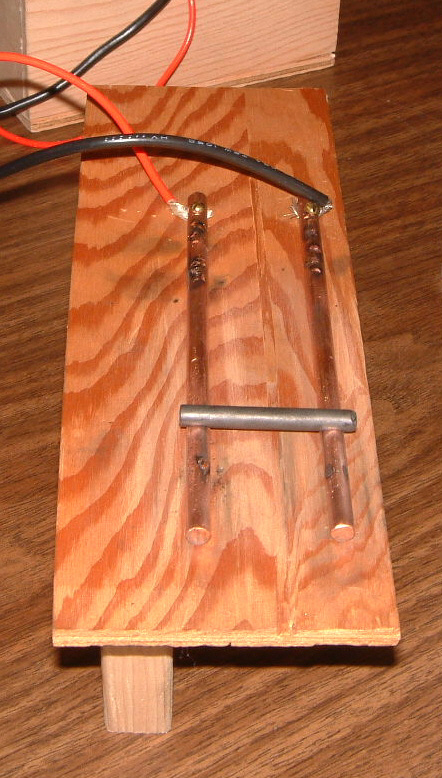 The
model rail gun is shown to the left. The two parallel rails are made
of copper and the shiny grey bar connecting them is the graphite projectile.
Graphite was chosen because it is a good conductor and it doesn't melt.
The second quality is important, since a lot of heat is generated at the
point of contact between the projectile and rails. 400 Volts are
used to power this device and with a total resistance of about 5 Ohms a
peak current of 80 Amps initially flows through the circuit (I = V/R).
That current is more than enough to blow a 15 Amp fuse which protects the
electrical wall outlet in a North American home! If a copper projectile
were used instead of graphite, it would be welded to the rails and not
move at all. This is actually the principle used by spot welders,
which are often part of high school shop classes: a large current
is passed through a small area of metal, producing enough heat to melt
two pieces together.
The
model rail gun is shown to the left. The two parallel rails are made
of copper and the shiny grey bar connecting them is the graphite projectile.
Graphite was chosen because it is a good conductor and it doesn't melt.
The second quality is important, since a lot of heat is generated at the
point of contact between the projectile and rails. 400 Volts are
used to power this device and with a total resistance of about 5 Ohms a
peak current of 80 Amps initially flows through the circuit (I = V/R).
That current is more than enough to blow a 15 Amp fuse which protects the
electrical wall outlet in a North American home! If a copper projectile
were used instead of graphite, it would be welded to the rails and not
move at all. This is actually the principle used by spot welders,
which are often part of high school shop classes: a large current
is passed through a small area of metal, producing enough heat to melt
two pieces together.
The Capacitor:
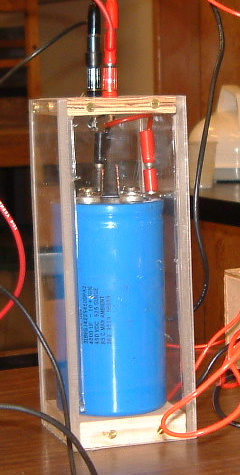 The
capacitor is just like a battery except that it's capable of discharging
its energy very quickly. The reason a battery is slower is that it
generates energy using a chemical reaction and there is a limit to the
rate of this reaction, which imposes a limit on the rate of energy production.
A capacitor, on the other hand, doesn't generate energy, instead, it stores
energy. It must be charged by a power supply. Connecting positive
to negative on a charged capacitor is like punching a hole in a water dam.
Enormous amounts of potential energy (gravitational potential energy in
the case of the water dam, electric potential in the case of the capacitor)
are released as quickly as possible. For
a video showing the capacitor being discharged please click here.
The
capacitor is just like a battery except that it's capable of discharging
its energy very quickly. The reason a battery is slower is that it
generates energy using a chemical reaction and there is a limit to the
rate of this reaction, which imposes a limit on the rate of energy production.
A capacitor, on the other hand, doesn't generate energy, instead, it stores
energy. It must be charged by a power supply. Connecting positive
to negative on a charged capacitor is like punching a hole in a water dam.
Enormous amounts of potential energy (gravitational potential energy in
the case of the water dam, electric potential in the case of the capacitor)
are released as quickly as possible. For
a video showing the capacitor being discharged please click here.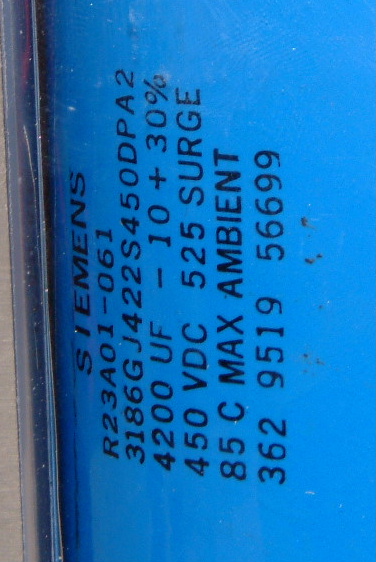 A picture of the capacitor is shown on the left, where it is enclosed inside
a plexiglass box for safety.
A picture of the capacitor is shown on the left, where it is enclosed inside
a plexiglass box for safety.
The amount of charge a capacitor can store per volt is called it's capacitance,
and is measured in a unit called Farads, abbreviated F. Charge, as
you know, is measured in Coulombs, so 1 F = 1 Coulomb per Volt. The
capacitor used here has an exceptionally high capacitance of 4.2 mF (milliFarads).
Capacitors are usually rated in µF (microFarads), so this one, being
rated in mF means its capacitance is very large. The picture on the
right shows a close-up shot of the exact specifications of this capacitor,
which was made by Siemens.
The Magnet:
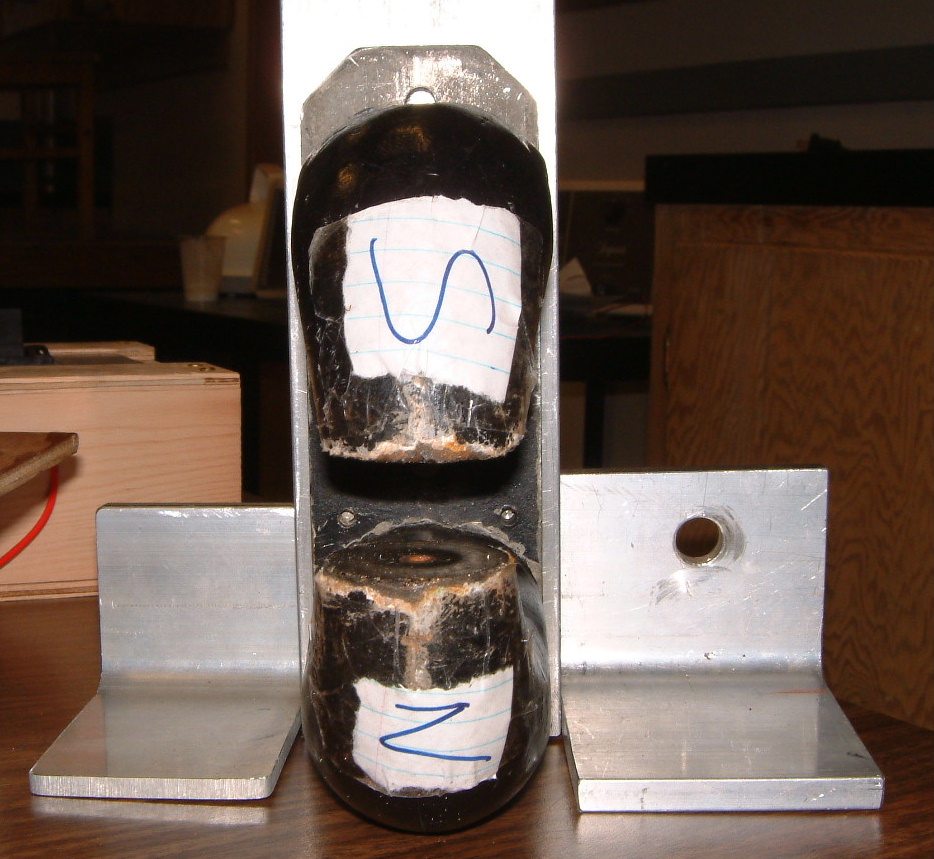 A
very strong magnet is used for this demonstration, which is shown to the
left with the South and North poles labeled S and N. The rail gun
can work without any such magnet, but having one causes the projectile
to fly much further. Exactly why is explained in "WHY
IT WORKS". This magnet has a strength of 0.2 Tesla (a Tesla is
defined as the strength of a magnetic field that will exert a force of
1 Newton on a charge of 1 Coulomb when the charge is moving at a speed
of 1 meter per second in a direction perpendicular to the field.
Now that's a mouthful! Understanding the definition of a Tesla is
not necessary for understanding the rail gun.) Suffice it to say,
the magnet is strong enough that if the poles where to touch it would be
impossible to separate them by hand.
A
very strong magnet is used for this demonstration, which is shown to the
left with the South and North poles labeled S and N. The rail gun
can work without any such magnet, but having one causes the projectile
to fly much further. Exactly why is explained in "WHY
IT WORKS". This magnet has a strength of 0.2 Tesla (a Tesla is
defined as the strength of a magnetic field that will exert a force of
1 Newton on a charge of 1 Coulomb when the charge is moving at a speed
of 1 meter per second in a direction perpendicular to the field.
Now that's a mouthful! Understanding the definition of a Tesla is
not necessary for understanding the rail gun.) Suffice it to say,
the magnet is strong enough that if the poles where to touch it would be
impossible to separate them by hand.
The Model:
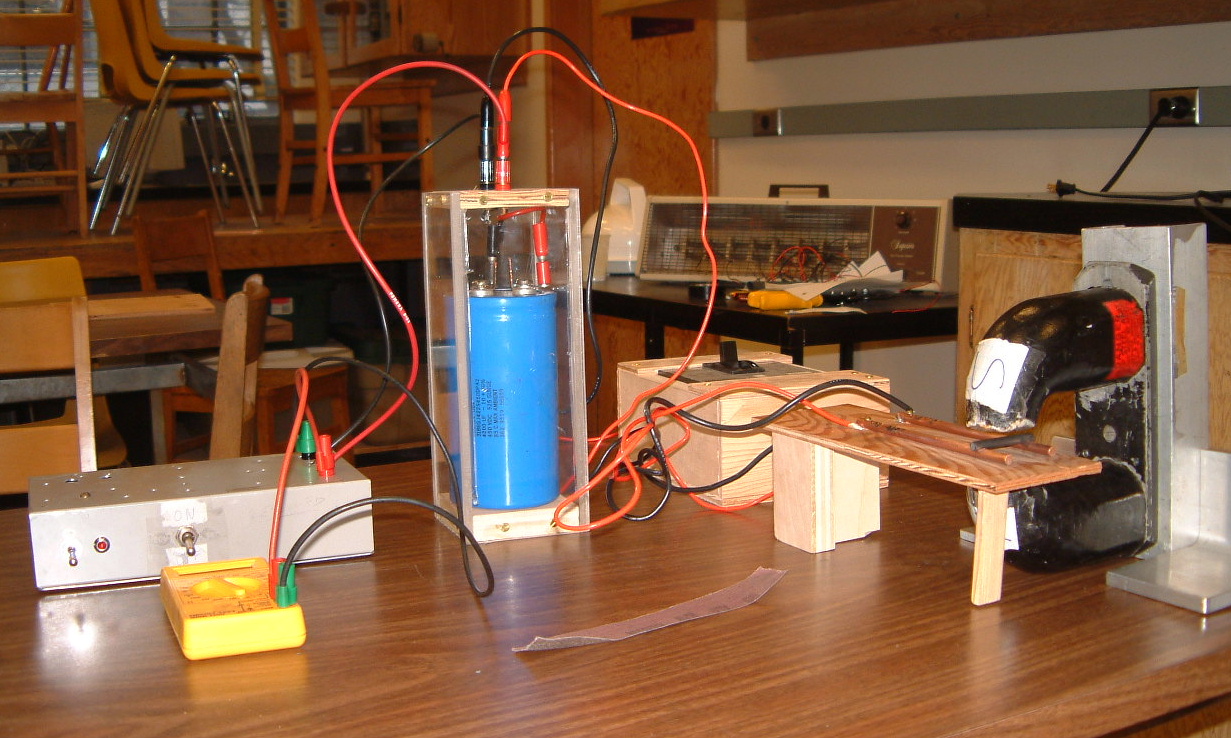 The
entire model is pictured here. The shiny grey box to the left
of the capacitor is the 450V DC power supply I built. For
information about it please click here. The yellow box in front
of it is a voltmeter. The large wooden box on the right of the capacitor
encloses a large switch (actually a main circuit breaker) which controls
the connection between the capacitor and the rails. The strip of
sand paper lying on the table in front of the capacitor is needed to smooth
out the pits and remove burn marks from the rails created by heat during
each firing. Please also notice the magnet and rails.
The
entire model is pictured here. The shiny grey box to the left
of the capacitor is the 450V DC power supply I built. For
information about it please click here. The yellow box in front
of it is a voltmeter. The large wooden box on the right of the capacitor
encloses a large switch (actually a main circuit breaker) which controls
the connection between the capacitor and the rails. The strip of
sand paper lying on the table in front of the capacitor is needed to smooth
out the pits and remove burn marks from the rails created by heat during
each firing. Please also notice the magnet and rails.